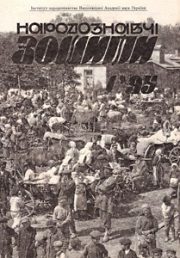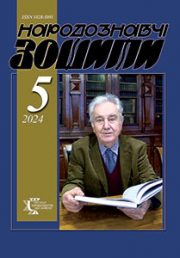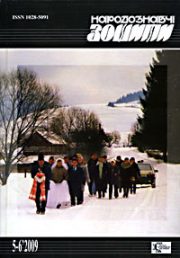The Ethnology Notebooks. 2025. № 4 (184), 969—978
UDK726.95:745.51:64](477)”16/17″:069](477)(045)
DOI https://doi.org/10.15407/nz2025.04.969
THE CROSSES ON THE UKRAINIAN EARLY MODERN PERIOD CEILING BEAMS
SHCHERBAN Anatolii
- ORCID ID: https://orcid.org/0000-0002-9530-6453
- Doctor of Culturolodgy, Candidate of Historical Sciences,
- Professor, Head of the Department of Culturology and Museum Activity,
- Kharkiv State Academy of Culture,
- 4, Bursatskyi uzviz, 61057, Kharkiv, Ukraine,
- Contacts: e-mail: kosaks_1978@ukr.net
VEKLENKO Viktor
- ORCID ID: https://orcid.org/0000-0002-9530-6453
- Director, Public Historical-Ethnographic
- Stavrographic Museum of the Cross, 28, Kozatska St., 51813,
- Hrechane village, Dnipropetrovsk region, Ukraine,
- Contacts: e-mail: vik88tormusseum@gmail.com
Abstract. Problem Statement. The study of crosses as a significant component of Ukrainian cultural heritage has been extensively covered in scholarly literature. However, their depictions on ceiling beams (svoloky) from the Early Modern period remain largely underexplored. Given the abundance of such signs, along with the frequent availability of information about the owner, the original location, and the date of creation, these artifacts represent a valuable resource for the field of cross studies.
Purpose. To provide a comprehensive overview of crosses depicted on Ukrainian ceiling beams of the Early Modern era, analyzing them as elements of decoration, markers and symbols.
Methods. The complex of methods and approaches characteristic of museological, historical and art history disciplines were involved. In particular, the principle of historicism, methods of comparative and visual analysis, formal-stylistic.
Results. The study summarizes the analysis of 29 carved crosses found on 26 Ukrainian ceiling beams (svoloky) dated between 1667 and 1780. These ceiling beams originate from museum and reserve collections and from photographs and drawings.
Conclusion. The cross is a meaningful and semantically rich element of the «carved» Ukrainian ceiling beams from the Early Modern period. It appears on 73% of the examined items from 1667—1780. Four regional groups of ceiling beams bearing such signs have been identified. «northern» region includes three examples. The «southern» region includes two examples. All featuring six-pointed crosses of a single type but with different ornamentation and lower crossbars. The «western» group comprises three ceiling beams, but their crosses are of varied types. The most representative region is Central Naddniprianshchyna, with 17 ceiling beams, displaying a diversity of cross types and variations. This variety may indicate that the crosses were carved by artisans from different woodworking centers and that there was no universally accepted canon for the image of the cross as a domestic symbol in certain Ukrainian lands during the late 17th to 18th centuries. It may also reflect historical changes in church life.
Keywords: wood, carving, ceiling beam (svolok), сross.
Received 2.07.2025
REFERENCES
- Shcherban, A. (2024). Beam of the 1758 and the Church History of the Urban-Type Settlement of Dashiv: A Rethinking. Folk Art and Ethnology, 4 (404), 110—118. DOI: 10.15407/nte2024.04.110 [in Ukrainian].
- Shcherban, A., & Babkova, N. (2023). Ceiling beam (svolok) 1741 from the Dykanka Historical and Local Story Museum. The Ethnology Notebooks, 6 (174), 1386—1396. DOI: 10.15407/nz2023.06.1386 [in Ukrainian].
- Shcherban, A., & Zham, O. (2025). A carved beam from the collection of Mykola Biliashivskyi, 1907. Research, preservation and popularization of monuments of historical and cultural heritage of Ukraine (to the 110th anniversary of the birth of P.T. Tronko) (Pp. 72—83). Pereyaslav [in Ukrainian].
- Shcherban, A., & Chebotariova, L. (2025). Carved ceiling beams of the Early Modern Period from the Vasyl Krychevsky Poltava Local Lore Мuseum. Poltava Local Lore Мuseum: Little-known pages of history, museology, care of monuments (Vol. XX, pp. 707—722) [in Ukrainian].
- Shcherban, A., & Yurchenko, A. (2025). Attribution of the ceiling beam (svolok) of 1733. New research of monuments of the Cossack era in Ukraine, 34, 182—188 [in Ukrainian].
- Vasylenko, A.Yu. (2010). The ornament on the ceiling beams of the Cossack age: interpretation and analysis of elements. Khortytsya Nature Reserve. The history of the Zaporizhzhya Cossacks: in monuments and museum practice (Proceedings of the IV international Scientific and Practical Conference). Zaporizhzhia: A&V. Art CROUP [in Ukrainian].
- Shcherban, A. (2024). Carved ceiling beam (svolok) from the Hetmanate in the collection of the Katerynoslav Museum. INSULA, 7, 359—372 [in Ukrainian].
- Shcherban A., & Babkova N. (2024). Carved support beams of the Hetmanate. History of Science and Technology, 14 (1), 184—212. DOI: 10.32703/2415-7422-2024-14-1-184-212.
- Chekal, O. (2025). Ukrainian sacred design: exploring the visual identity of Ortodox church of Ukraine through theo-aesthetics, fonts and multicultural influences. Church and Society, 1 (9), 85—97 [in Ukrainian].
- Pavlutsky, G. (1911). Civil architecture in Ukraine. In: Grabar I. History of Russian art in Pre-Petrine era. (Moscow and Ukraine). Architecture (Vol. 2, pp. 414—415). Moscow: Edition I. Knebel [in Russian].
- Metrical book. The register of births, marriages and deaths of the village of Krasnoye in the Plavuchaya Velika parish for the years 1745—1776. Institute of Manuscript of V.I. Vernadsky National Library of Ukraine. F. XVIII. Od. save 445 [in Russian].
- Shcherban, A. (2024). Carved ceiling beams (svoloky) of the Early Modern Period from northern Ukraine. New research of monuments of the Cossack era in Ukraine, 33, 21—29 [in Ukrainian].
- Veklenko, V. (2020). Volyn crosses: questions of identification. Old Lutsk. Scientific and informational collection (Issue XVІ, pp. 175—188). Lutsk [in Ukrainian].
- (1962). Ukrainian folk art. Carving and artistic metal arranged. Kyiv: State Publishing House of Fine Arts and Fiction [in Ukrainian].
- Veklenko, V.O., Marina, Z.P., & Romashko, O.V. (2023). Creation and development of Ukrainian chrestology: philosophical search and ways of implementation. Svichado Prydniprovya. Local history almanac: collection of local history and scientific works (Pp. 218—245) [in Ukrainian].
- Shcherban, A. (2010). Depictions of Christian symbols in the Opishne dungeons. Development of underground space of the Kharkiv region (Proceedings of the scientific and practical conference). Kharkiv [in Ukrainian].
- Veklenko, V. (2020). Ukrainian vest and pectoral crosses of the 18th—19th centuries from the territory of Cherkasy region. New research of monuments of the Cossack era in Ukraine, 29, 144—157 [in Ukrainian].
- Zham, O., & Hrudevych, T. (2021). The ceiling beam (svolok) from chinbar`s house at the Museum of Folk Architecture and Life of the Middle Dnieper: historical, graphical and artistical review. Siverian chronicle, 6, 25—35. DOI: 10.5281/zenodo.5804536 [in Ukrainian].
- Evarnickij, D.I. (1888). Zaporozhye in the remnants of antiquity and folk tales (Vol. 2). Sankt-Peterburg: Izdanie L.F. Panteleeva [in Russian].
- Tkachuk, D. (1928). The svolok from Krekhiv, 17th century. Notes of the Order of St. Basil the Great (Vol. 3, issue 1—2, pp. 247). Zhovkva [in Ukrainian].
- Yatsenko, S.P. (2010). The beam from the Zaporizhzhia District Local Lore Museum collection. Muzejnyj visnyk, 10, 9—15 [in Ukrainian].
- Hlushchenko, A., & Tkachenko, K. (2024). The ceiling beam (svolok) from Keleberda in the collection of the Local History Museum of the city of Horishni Plavni: an attempt at attribution. Svichado Prydniprovya. Local history almanac: collection of local history and scientific works (Issue ХІІІ, pp. 246—249) [in Ukrainian].







